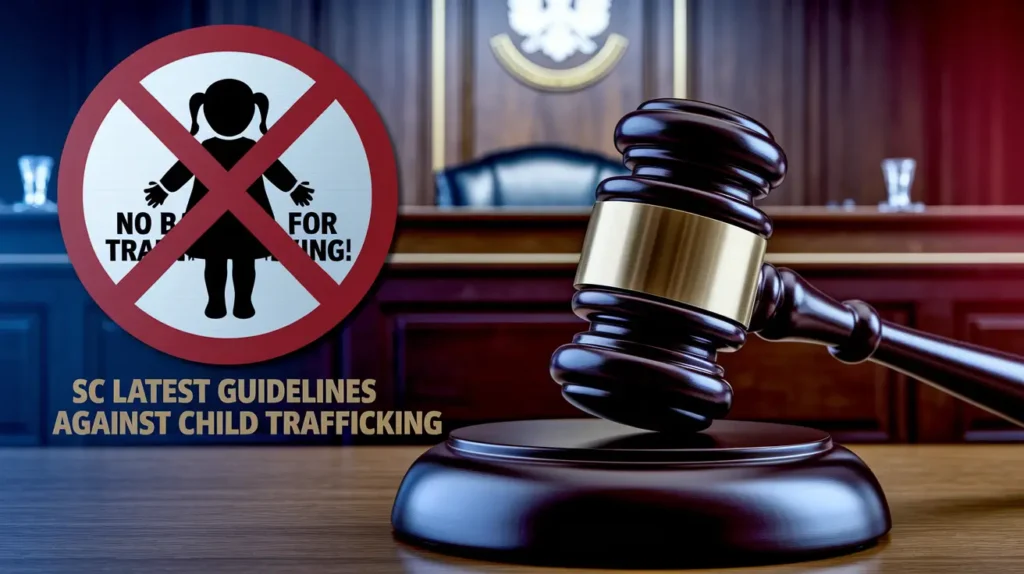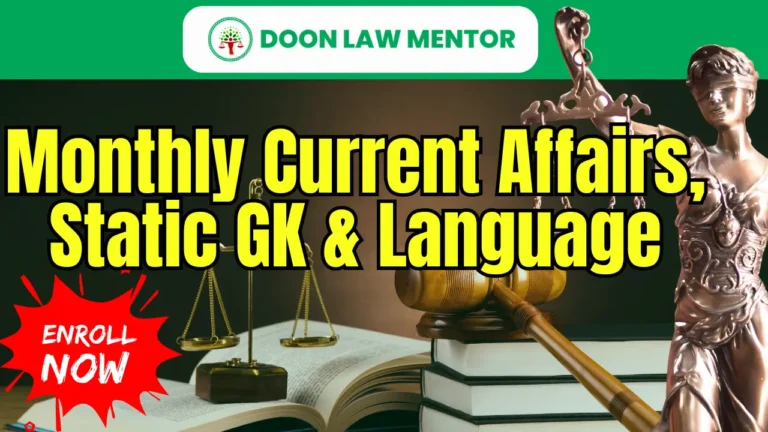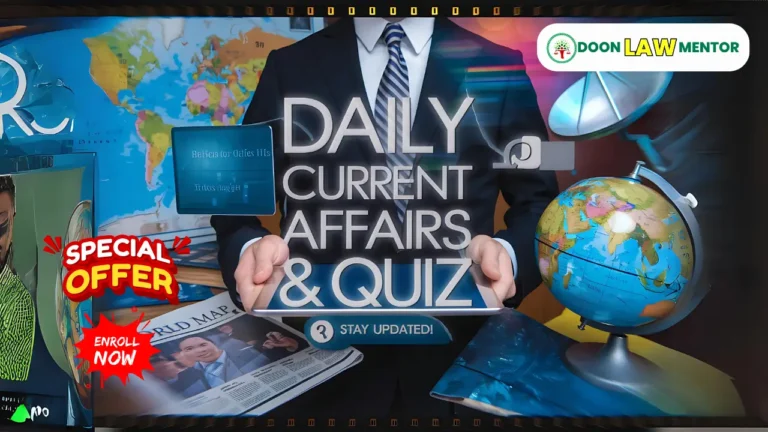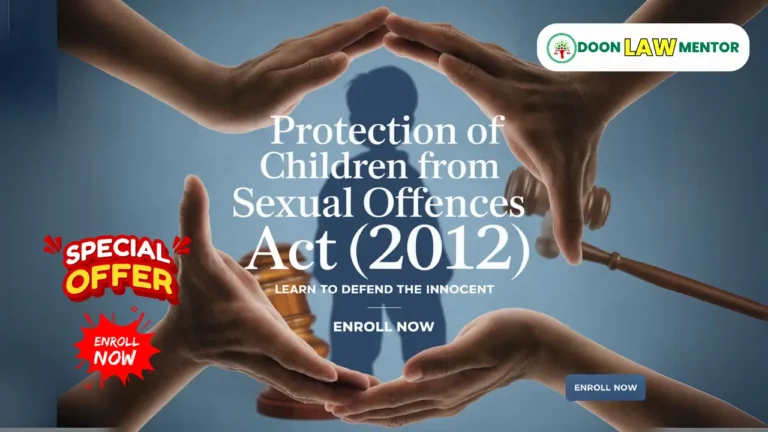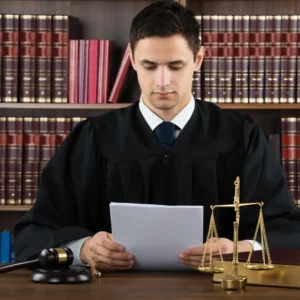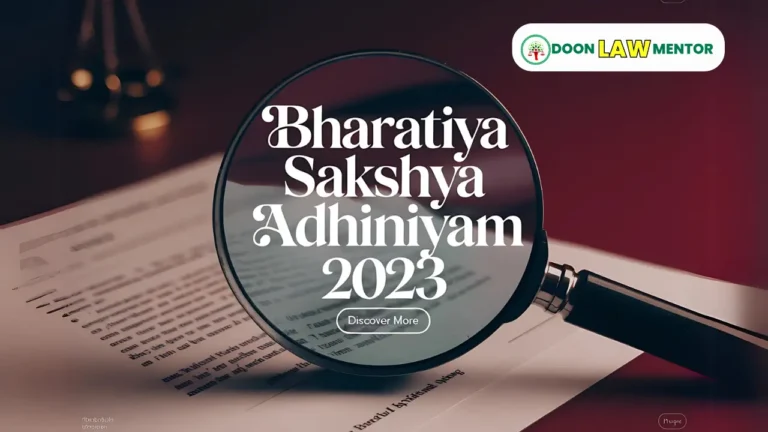In the 2025 case Pinki v. State of Uttar Pradesh, the Supreme Court issued the SC Child Trafficking Guidelines 2025, canceling bail for 13 accused and mandating hospital license suspension for newborn trafficking. This ruling aims to curb child trafficking effectively. This blog explains the SC Child Trafficking Guidelines 2025 for Judiciary, APO, and JLO aspirants preparing for 2025 exams.
Table of Contents
Introduction
On April 15, 2025, the Supreme Court of India issued a landmark ruling in Pinki v. State of Uttar Pradesh and Anr., introducing the SC Child Trafficking Guidelines 2025 to combat the rising menace of child trafficking. The Court canceled the bail of 13 accused involved in inter-state child trafficking, criticized the Uttar Pradesh government and Allahabad High Court for their lax approach, and mandated immediate license suspension for hospitals complicit in newborn trafficking. This decision addresses systemic failures in handling child trafficking cases and sets a new standard for accountability and swift justice. For Judiciary, APO, and JLO aspirants, understanding the SC Child Trafficking Guidelines 2025 is essential for your 2025 exams, offering insights into criminal law, judicial oversight, and child protection. This blog breaks down the case, the Court’s directives, and their implications in simple terms to help you prepare effectively.
What Happened in Pinki v. State of Uttar Pradesh (2025)?
The SC Child Trafficking Guidelines 2025 emerged from a case involving a widespread child trafficking racket in Uttar Pradesh. Let’s explore the details.
The Child Trafficking Racket
In Pinki v. State of Uttar Pradesh and Anr. (Criminal Appeal No. 1927 of 2025), the Supreme Court addressed a series of inter-state child trafficking cases. The accused, a group of 13 individuals, were part of a large network operating within and outside Delhi, trafficking infants and children across states for sums ranging from Rs. 5,00,000 to Rs. 10,00,000. One specific instance involved a stolen newborn delivered to a couple in Uttar Pradesh who paid Rs. 4 lakh for a son, knowing the child was trafficked. The network was well-organized, using smartphones to share information, photographs, transfer money, and coordinate locations, highlighting the sophisticated nature of the crime.
Initial Bail by Allahabad High Court
The Allahabad High Court had granted bail to the 13 accused, citing reasons such as their names not being in the FIR, their identities being disclosed by a co-accused, the victims not being recovered from their custody, and parity with other co-accused who were also granted bail. The High Court imposed conditions requiring the accused to appear before the trial court and not tamper with evidence or pressure witnesses. However, most of the accused absconded after receiving bail, failing to attend court proceedings, which led to the police losing track of them.
Petition to the Supreme Court
The kin of the trafficked children, represented by Senior Advocate Aparna Bhat, filed a petition in the Supreme Court to challenge the High Court’s bail orders, leading to the SC Child Trafficking Guidelines 2025. Bhat argued that some of the accused, including nurses working in healthcare centers, had directly facilitated the trafficking of children, retrieving at least four victims from buyers to whom they had sold them. She contended that granting bail to such individuals posed a serious risk, as they could return to their workplaces and continue their illegal activities. Advocate Garvesh Kabra, representing the State of Uttar Pradesh, supported Bhat’s arguments, noting that the whereabouts of most accused were unknown, further complicating the case.
Supreme Court’s Intervention
On April 15, 2025, a bench of Justices JB Pardiwala and R. Mahadevan took a stern stance in the SC Child Trafficking Guidelines 2025 ruling. The Court canceled the bail of all 13 accused, ordered their immediate surrender, and issued comprehensive guidelines to prevent child trafficking and ensure swift justice. The ruling also addressed systemic failures by the Uttar Pradesh government and the Allahabad High Court, setting a precedent for handling such cases nationwide.
What Did the Supreme Court Say?
The Supreme Court issued several key observations and directives in the SC Child Trafficking Guidelines 2025, focusing on accountability, prevention, and expedited justice. Let’s break down its findings.
Criticism of the Uttar Pradesh Government
The Court expressed deep disappointment with the Uttar Pradesh government’s handling of the SC Child Trafficking Guidelines 2025 case. It stated, “We are thoroughly disappointed with the manner in which the State handled the situation. Why did the State not do anything for all this period of time? Why did the State not deem fit to challenge the orders of bail passed by the High Court? The State unfortunately has exhibited no seriousness worth the name.” The bench criticized the state for not appealing the High Court’s bail orders, highlighting a lack of seriousness in addressing the grave issue of child trafficking.
Read More: Future of Legal Education: Is Online Learning the New Standard?
Criticism of the Allahabad High Court
The Court also slammed the Allahabad High Court for its “callous” approach in granting bail to the accused in the SC Child Trafficking Guidelines 2025 case. It noted, “We are sorry to say but the High Court dealt with all the bail applications in a very callous manner. The outcome of this callous approach on the part of the High Court has ultimately paved way for many accused persons to abscond and thereby put the trial in jeopardy.” The bench pointed out that the High Court failed to impose adequate conditions, such as requiring the accused to mark their presence weekly at a police station. Instead, the High Court only directed them to appear before the trial court, leading to the police losing track of the accused after they absconded.
Cancellation of Bail and Judicial Custody
The Supreme Court canceled the bail of all 13 accused in the SC Child Trafficking Guidelines 2025 ruling, ordering them to surrender before the committal court. It directed, “All the accused persons are directed to surrender before the committal court and the committal court in turn shall remand them to judicial custody.” The Court emphasized that the accused posed a “big threat to society” due to their tendency to engage in child trafficking, necessitating strict measures to prevent further harm.
Hospital License Suspension for Newborn Trafficking
A groundbreaking directive in the SC Child Trafficking Guidelines 2025 was the mandate for immediate license suspension of hospitals complicit in newborn trafficking. The Court stated, “If any newborn infant is trafficked from any hospital, the immediate action against the hospital should be suspension of licence to run the hospital over and above other actions in accordance with law.” It further underscored, “When any lady comes to deliver her baby in any hospital, it is the responsibility of the administration of the hospital to protect the newborn infant in all respects.” This measure aims to hold healthcare institutions accountable and deter trafficking at its source.
Read More: Justice BR Gavai Next Chief Justice of India
Expedited Trials and General Directions
The Court issued comprehensive guidelines under the SC Child Trafficking Guidelines 2025 to expedite trials and ensure justice in child trafficking cases:
- Committal and Framing of Charges: The Chief Judicial Magistrate and Additional Chief Judicial Magistrate in Varanasi were directed to commit the three criminal cases to the sessions court within two weeks, with charges to be framed within one week thereafter.
- Non-Bailable Warrants for Absconding Accused: If any accused abscond, the trial court must issue non-bailable warrants immediately, separating their trial to avoid delays for others.
- Six-Month Trial Deadline: Trials must be completed within six months, with day-to-day hearings if necessary.
- Appointment of Special Public Prosecutors: The state was directed to appoint three special public prosecutors experienced in criminal trials to handle these cases.
- Police Protection for Victims: The state must provide police protection to victims and their families to prevent evidence tampering during the trial.
- Tracing Absconding Accused: The state police were given two months to trace and apprehend absconding accused.
- Education for Victims: Trafficked children must be admitted to schools under the Right of Children to Free and Compulsory Education Act, 2009, with ongoing state support.
- Compensation for Victims: At the end of the trial, courts must award compensation to victims under the Bharatiya Nagarik Suraksha Sanhita (BNSS) 2023, including through the Uttar Pradesh Rani Laxmi Bai Mahila Evam Bal Samman Kosh.
- High Court Oversight: All High Courts must collect data on pending child trafficking trials, issue circulars to complete trials within six months, and report compliance to the Supreme Court.
- Implementation of BIRD Report: States must implement the 2023 Bharatiya Institute of Research and Development (BIRD) report recommendations, such as treating missing children cases as abductions unless proven otherwise.
Read More: Judiciary Exam Prep Limited Resources: 7 Effective Strategies for 2025
Suo Motu Cognizance of Trafficking Gangs
The Court took suo motu cognizance of a Times of India report from April 14, 2025, which revealed a large child trafficking gang operating within and outside Delhi, selling infants for Rs. 5,00,000 to Rs. 10,00,000. The bench noted that the traffickers were well-networked, using smartphones to coordinate their activities, and directed the investigating officer to submit a status report on measures to dismantle these networks. The matter is scheduled for further hearing on April 21, 2025.
Emotional Impact on Parents
Justice JB Pardiwala highlighted the emotional toll of child trafficking, stating, “The pain and agony which any parents may face when their child dies is different from the pain and agony they may experience when they lose their children to such gangs engaged in trafficking. It is worse than death.” The Court urged parents to remain vigilant, emphasizing the lifelong trauma of losing a child to trafficking compared to the closure that comes with death.
What Does This Ruling Mean?
The SC Child Trafficking Guidelines 2025 ruling has far-reaching implications for child protection, healthcare accountability, and the justice system in India. Let’s break down its significance in simple terms.
Good Points of the Ruling
- Swift Justice for Victims: The SC Child Trafficking Guidelines 2025 mandate a six-month trial deadline with day-to-day hearings, ensuring victims receive justice quickly and reducing the trauma of prolonged legal battles.
- Hospital Accountability: The directive to suspend hospital licenses for newborn trafficking under the SC Child Trafficking Guidelines 2025 holds healthcare institutions accountable, deterring complicity in trafficking and ensuring better protection for newborns.
- No Bail for Accused: By canceling bail and ordering judicial custody, the Court ensures that dangerous traffickers remain off the streets, preventing further crimes and protecting society.
- Comprehensive Support for Victims: The SC Child Trafficking Guidelines 2025 include provisions for education and compensation, helping trafficked children rebuild their lives and ensuring their rights under the Right to Education Act are upheld.
- Systemic Reforms: The guidelines address systemic failures by mandating High Court oversight, special prosecutors, and police protection, strengthening the overall response to child trafficking.
Things to Think About
- Will States Comply? The SC Child Trafficking Guidelines 2025 impose strict deadlines and accountability measures, but will states like Uttar Pradesh, criticized for laxity, implement these effectively? Non-compliance could lead to contempt proceedings, as warned by the Court.
- Hospital License Suspension Challenges? While the license suspension directive is strong, hospitals may challenge such actions legally, arguing procedural unfairness or lack of evidence, which could delay enforcement.
- Can Police Track Absconding Accused? The two-month deadline to apprehend absconding accused under the SC Child Trafficking Guidelines 2025 is ambitious, but the well-networked nature of trafficking gangs may pose challenges for the police.
- Impact on Healthcare Access? Immediate license suspension for hospitals could disrupt healthcare access for other patients, especially in rural areas with limited facilities, raising questions about balancing accountability with public health needs.
- Will Trials Be Effective? The six-month trial deadline is a positive step, but factors like witness hostility, inadequate evidence, or resource constraints might hinder convictions, as noted in the BIRD report.
Why This Matters
The SC Child Trafficking Guidelines 2025 ruling addresses a critical social issue—child trafficking—by setting strict standards for prevention, prosecution, and victim support. It highlights the judiciary’s role in protecting vulnerable children, holding state authorities accountable, and ensuring swift justice. The guidelines also reflect the Court’s commitment to systemic reform, making them a landmark in child protection law.
Why This Matters for Judiciary, APO, and JLO Aspirants
The SC Child Trafficking Guidelines 2025 are crucial for your 2025 exams. For Prelims, learn the case name Pinki v. State of Uttar Pradesh (2025), key directives like hospital license suspension, and provisions like the Right to Education Act, 2009, and BNSS 2023 compensation. For Mains, write essays on child trafficking laws, judicial oversight in criminal cases, or the role of hospitals in preventing trafficking, using this case. For Interviews, discuss how these guidelines balance accountability with justice, citing examples like the six-month trial deadline and police protection for victims.
Conclusion
The SC Child Trafficking Guidelines 2025 in Pinki v. State of Uttar Pradesh (2025) mark a pivotal moment in India’s fight against child trafficking. The Supreme Court canceled the bail of 13 accused, criticized the Uttar Pradesh government and Allahabad High Court for their negligence, and issued groundbreaking directives, including immediate hospital license suspension for newborn trafficking and a six-month trial deadline for such cases. The SC Child Trafficking Guidelines 2025 also ensure victim support through education and compensation, while mandating High Courts to oversee compliance. This ruling underscores the judiciary’s commitment to protecting children, holding authorities accountable, and ensuring swift justice. For Judiciary, APO, and JLO aspirants, this case is vital for your 2025 exams. It teaches you about child trafficking laws, judicial oversight, and victim rights under the BNS and BNSS. Study the SC Child Trafficking Guidelines 2025 to excel in your exams. Start preparing with this case today to reach your goals in 2025!
Call-to-Action
Learn the SC Child Trafficking Guidelines 2025 for your 2025 exams! Join Doon Law Mentor’s Courses for help. Follow @doonlawmentor on Instagram for daily updates!
FAQs
- What are the SC Child Trafficking Guidelines 2025 in the Pinki case?
The guidelines include canceling bail for accused, suspending hospital licenses for newborn trafficking, and mandating six-month trials. - What is the name of the SC Child Trafficking Guidelines 2025 case?
The case is Pinki v. State of Uttar Pradesh and Anr. (2025). - Why did the Supreme Court cancel bail in the SC Child Trafficking Guidelines 2025 case?
The Court canceled bail because the accused absconded after the Allahabad High Court granted it without proper conditions. - What did the Supreme Court say about hospitals in the SC Child Trafficking Guidelines 2025?
It ruled that hospitals must lose their licenses immediately if newborns are trafficked from their premises. - What did the Uttar Pradesh government do wrong in the SC Child Trafficking Guidelines 2025 case?
The state failed to challenge the High Court’s bail orders, showing a lack of seriousness, as per the Court. - What are the trial deadlines in the SC Child Trafficking Guidelines 2025?
Trials must be completed within six months, with day-to-day hearings if needed. - How does the SC Child Trafficking Guidelines 2025 support victims?
It ensures education for victims under the Right to Education Act and compensation at the end of trials. - What is the BIRD report in the SC Child Trafficking Guidelines 2025?
It’s a 2023 report by the Bharatiya Institute, recommending treating missing children cases as abductions until proven otherwise. - What happens to absconding accused under the SC Child Trafficking Guidelines 2025?
The Court ordered non-bailable warrants and gave the police two months to apprehend them. - Why are the SC Child Trafficking Guidelines 2025 important for aspirants?
They teach about child trafficking laws, judicial accountability, and victim rights, which are key for your 2025 exams.
#SCChildTraffickingGuidelines2025, #PinkiVStateOfUP2025, #SupremeCourtChildTrafficking, #JudiciaryExams #Doonlawmentor #bestjudiciarycoaching

